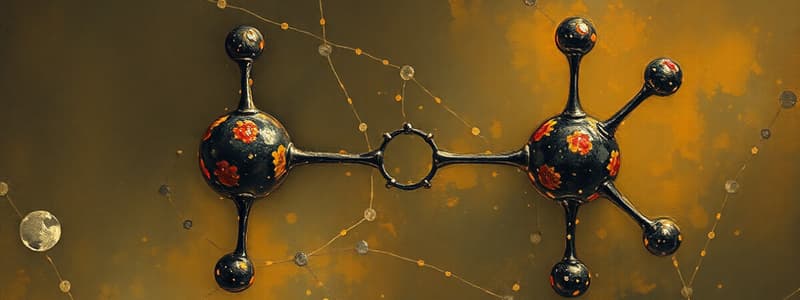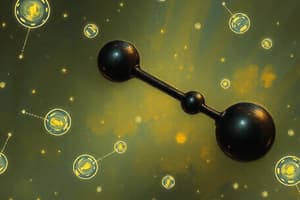Podcast
Questions and Answers
What type of bonds are present in the triple bond of acetylene?
What type of bonds are present in the triple bond of acetylene?
- 1 sigma bond and 2 pi bonds (correct)
- 3 sigma bonds
- 1 sigma bond and 1 pi bond
- 2 sigma bonds and 1 pi bond
How many electron clouds surround the central carbon atom in acetylene?
How many electron clouds surround the central carbon atom in acetylene?
- 1
- 2
- 3 (correct)
- 4
What is the hybridization of the central carbon atom in methane (CH4)?
What is the hybridization of the central carbon atom in methane (CH4)?
- sp3d
- sp3 (correct)
- sp
- sp2
Why are the pure atomic 2p orbitals in acetylene kept unhybridized?
Why are the pure atomic 2p orbitals in acetylene kept unhybridized?
According to Valence Bond theory, what happens to atomic orbitals during bond formation?
According to Valence Bond theory, what happens to atomic orbitals during bond formation?
What is the primary reason for nitrogen's hybridization in ammonia (NH3)?
What is the primary reason for nitrogen's hybridization in ammonia (NH3)?
Which geometry describes the arrangement of bonds in methane (CH4)?
Which geometry describes the arrangement of bonds in methane (CH4)?
Which type of bond is formed in all single covalent bonds?
Which type of bond is formed in all single covalent bonds?
What is the composition of a double bond in ethylene?
What is the composition of a double bond in ethylene?
What do sp3 hybrid orbitals achieve in terms of bond properties in methane?
What do sp3 hybrid orbitals achieve in terms of bond properties in methane?
How many unpaired electrons does the nitrogen atom in ammonia have before hybridization?
How many unpaired electrons does the nitrogen atom in ammonia have before hybridization?
What is the bond angle in the tetrahedral geometry of methane (CH4)?
What is the bond angle in the tetrahedral geometry of methane (CH4)?
What is the primary reason why carbon requires unpaired electrons to form covalent bonds?
What is the primary reason why carbon requires unpaired electrons to form covalent bonds?
What occurs during the hybridization process of carbon in methane (CH4)?
What occurs during the hybridization process of carbon in methane (CH4)?
Which of the following describes the geometry of methane (CH4)?
Which of the following describes the geometry of methane (CH4)?
What characterizes sp3 hybrid orbitals that are formed during the hybridization process?
What characterizes sp3 hybrid orbitals that are formed during the hybridization process?
In the context of molecular bonding, what is a sigma bond?
In the context of molecular bonding, what is a sigma bond?
How many total sp3 hybrid orbitals does a single carbon atom form in CH4?
How many total sp3 hybrid orbitals does a single carbon atom form in CH4?
What is the significance of hybridization in covalent bonding?
What is the significance of hybridization in covalent bonding?
What does the hybridization of carbon in methane reveal about its bonding characteristics?
What does the hybridization of carbon in methane reveal about its bonding characteristics?
Which type of bond results from the side-to-side overlap of two p orbitals?
Which type of bond results from the side-to-side overlap of two p orbitals?
What is the effect of hybridization on the bonding in methane?
What is the effect of hybridization on the bonding in methane?
Study Notes
Chemical Bonding and Energy
- When a chemical bond forms, energy is released.
- Stronger bonds are formed with sp3 hybrid orbitals, which compensates for the energy required to promote the 2s electron to the 2p subshell.
Methane (CH4) Bonding
- Methane has a tetrahedral geometry due to the arrangement of four sp3 hybrid orbitals around the central carbon atom.
- All bonds in methane are identical in length and strength, with bond angles of 109.5 degrees.
Ammonia (NH3) Bonding
- Nitrogen in ammonia undergoes hybridization even though it has three unpaired electrons initially.
- sp3 hybridization allows for stronger bonds, which releases more energy.
- The trigonal pyramidal geometry of ammonia is a result of sp3 hybridization.
Water (H2O) Bonding
- Oxygen in water also undergoes sp3 hybridization, explaining the bent shape of the molecule.
Sigma (σ) Bonds
- Single covalent bonds are sigma bonds.
- Sigma bonds have cylindrical symmetry.
Pi (π) Bonds
- Pi bonds contribute to double and triple covalent bonds.
- A double bond consists of one sigma and one pi bond.
- A triple bond consists of one sigma and two pi bonds.
Ethylene Bonding
- The double bond in ethylene consists of one sigma and one pi bond.
- Carbon atoms in ethylene undergo sp2 hybridization, leaving one pure atomic 2p orbital unhybridized.
- The unhybridized 2p orbitals on both carbon atoms overlap to form the pi bond.
Acetylene Bonding
- The triple bond in acetylene is made up of one sigma and two pi bonds.
- Carbon atoms in acetylene undergo sp hybridization, leaving two pure atomic 2p orbitals unhybridized.
- These unhybridized 2p orbitals form the two pi bonds.
Hybrid Orbitals
- The type of hybrid orbital used can be predicted based on the number of electron regions around the central atom.
- Double and triple bonds count as one electron region.
- Lone pairs are also considered one electron region.
Valence Bond Theory
- Valence bond theory describes how and why chemical bonds form.
- It explains the molecular geometry of central atoms in molecules.
- According to valence bond theory, covalent bonds are formed by the overlap of atomic orbitals on adjacent atoms.
Studying That Suits You
Use AI to generate personalized quizzes and flashcards to suit your learning preferences.
Related Documents
Description
Explore the fundamental concepts of chemical bonding, including the role of energy in bond formation. Understand hybridization in molecules like methane, ammonia, and water, and the significance of sigma and pi bonds. This quiz will enhance your knowledge of molecular geometry and bond types.




